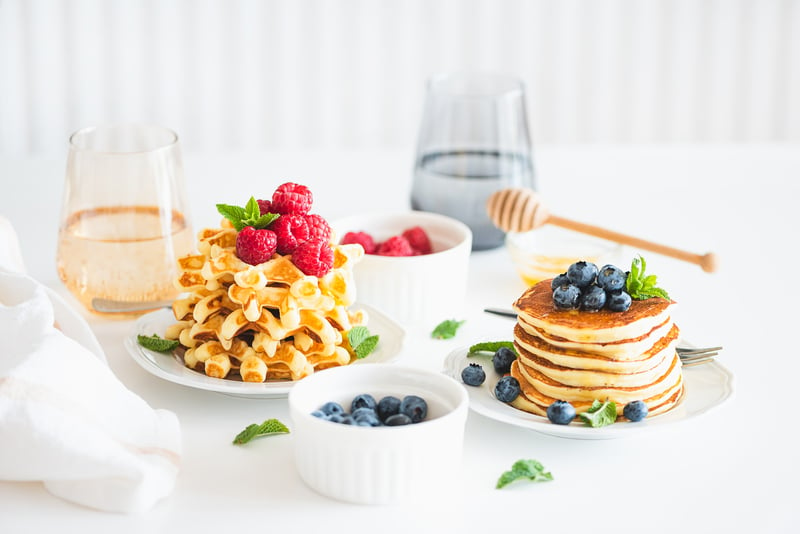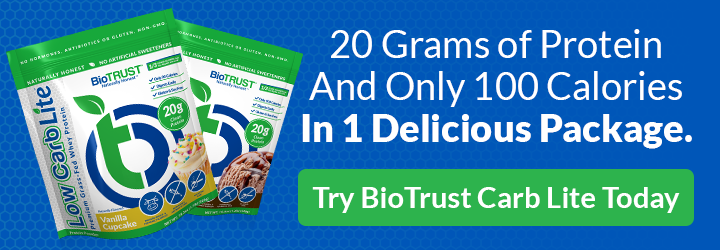Pancakes or Waffles: Which Breakfast Staple Is Healthier?

Made with flour, butter (or oil), milk, and eggs, at first glance, you may think pancakes or waffles are pretty much the same food, just in a slightly different form. In fact, many pre-made mixes or batters are used to make both pancakes and waffles. While both are popular breakfast foods, neither one appears all that healthy. This is especially true when made with refined white flour and oil and delivered via a server from your favorite greasy spoon, loaded, of course, with extra butter and syrup.
When made at home, though, you can change the equation and whip up a healthy choice that not only provides carbohydrates to power you through your day, but plenty of protein and fiber as well for extra staying power. Before we take a look at how to transform these popular breakfast foods, let’s see if one of these standard staples has an edge over the other.
Pancakes or Waffles: Is There a Clear Winner?
Whether you want pancakes or waffles, both are traditionally carb-tastic. In fact, you may be better off looking at both as a dessert rather than a balanced, healthy breakfast. That’s especially true when adding bottled syrup (especially made with corn syrup rather than real maple syrup) and whipped cream or even ice cream on top.
Both pancakes and waffles have a long history, but pancakes go wayyy back. They’ve been around since at least the 1400s (the first written record). Waffle irons, on the other hand, weren’t patented until the year 1869.
Pancakes and waffles can also both be found around the world. However, there are more versions of pancakes, including Asian pancakes, blini, crepes, Dutch pancakes, and even latkes. The most common waffle varieties include Belgian, Scandinavian sweetheart, and stroopwafels (which aren’t really waffles).
If you’re just looking at calorie count, waffles tend to tip the scales a bit more—adding an extra 100 calories to your plate before adding any butter, syrup, nuts, or whipped cream.
Nutritionally, a standard waffle has around 310 calories, 10 grams of fat, 49 grams of carbohydrates, and 7 grams of protein. A pancake, on the other hand, has 225 calories, 5 grams of fat, 39 grams of carbs, and 5 grams of protein. So, pancakes (as traditionally made) may be easier on the waistline, depending on how many are stacked on your plate.
Waffles, though, are higher in minerals like selenium, iron, calcium, magnesium, and zinc, as well as vitamins A, B1, B2, B3, B12, and C. Yet, pancakes are lower in saturated fat and sodium.
In addition, waffles tend to be made with more butter and sugar, which caramelizes when cooked. This gives them that crispy, rich, pastry-like texture and flavor. Because of the way they’re cooked, they also tend to be easier to get right.
Undercooked pancakes taste bitter and have an unappealing gummy texture. You can also make a pancake that is somehow underdone in the middle, overdone on the outside, and rubbery yet hard in a way that even an abundance of syrup can’t fix. However, when cooked perfectly, pancakes turn out soft, springy, and delicious. Pancakes can better absorb syrup while waffles trap the syrup in the little divots. In the end, as long as they’re properly prepared, taste-wise, the winner of pancakes or waffles is really in the mouth of the beholder.
One area where waffles do tend to edge out pancakes, however, is how they hold onto toppings. If you add chopped nuts or berries, for instance, waffles keep them well contained with the little squares. With pancakes, you’re more likely to have the toppings roll off the flat surface and escape.
In addition, waffles are so versatile as anyone who has been to a waffle bar can attest. They can be topped with butter, syrup, berries, whipped cream, ice cream, chocolate chips, candied sprinkles, etc., etc. But pancakes can also be turned into a dessert pretty easily with syrup, fruit compote, and whipped toppings. Waffles, though, tend to be better at it due to their texture.
With waffles, you don’t need to go sweet either. Waffles can be made into a delicious savory dinner when made with cheese, sourdough, or buttermilk. All that’s left is to top them with some fried chicken for the magical combination of chicken and waffles. Or layer on chili or creamy gravy. Waffles have the hearty texture to withstand the additions without turning into mush (as long as you don’t let them sit for too long).
With both pros and cons, proclaiming pancakes or waffles as a clear winner is impossible. It really comes down to personal preference.
Pancakes or Waffles: Healthier Versions
Made with traditional ingredients, it’s difficult to make a case for which one is healthier—even with the lower calorie count for pancakes and the nutrient edge for waffles. Fortunately, no matter which breakfast food you prefer, it’s super easy to make slight tweaks for a healthier, more calorie-conscious, satiating breakfast.
Starting with the toppings, you can easily forgo the traditional maple-flavored syrup and instead add a dollop of plain Greek yogurt (rich in protein and probiotics), a handful of fresh berries (high in fiber and antioxidants), and a drizzle of real maple syrup or honey. Or try a light smear of peanut butter and banana slices.
You can also sub out the standard plain white flour with one that’s higher in fiber and protein, such as oat, buckwheat, almond, chickpea, or whole wheat. You can even add a scoop or so of protein powder to your batter, which provides a richer flavor and gives your pancakes or waffles more staying power.
Whichever you choose, you can’t lose in terms of both flavor and health with any of the fantastic recipes below:
- Healthy Strawberry and Cream Waffles
- Protein Waffles with Fresh Fruit
- Pumpkin Spice Waffles
- Apple Pie Protein Waffles
- Chocolate Banana Pancakes
- Super Simple Vegan Pancakes
- Vegan Protein Pancakes
- Delicious Protein Pancakes
- Perfect Protein Pancakes
- Almond Flour Pancakes
- Delicious and Healthy Flapjacks for a Crowd
Whether you prefer pancakes or waffles is really subjective. Go with what you like best, or better yet, enjoy either one when the mood strikes. Just make some minor changes for a healthier version that provides the protein and fiber to keep you going for longer with the taste and texture you love. Or occasionally head over to your favorite greasy spoon for the “real thing”—just remember it’s more like a dessert than a healthy breakfast.




 7 Signs Your Body is Seriously Low on Collagen (not just wrinkles)
7 Signs Your Body is Seriously Low on Collagen (not just wrinkles) Health Expert: "Turmeric Doesn't Work (unless...)"
Health Expert: "Turmeric Doesn't Work (unless...)" 3 Warning Signs Your Probiotic Supplement is a Total Waste
3 Warning Signs Your Probiotic Supplement is a Total Waste

